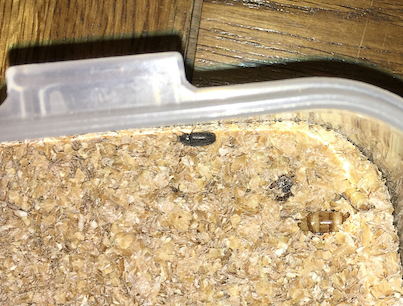Ant escapes and food. My three captive ant colonies have been very busy over the past few weeks. It has been very warm and dry outside.
I have recently purchased some more live food for my ants, namely, cockroaches and morio worms. Usually I buy enough of these to create breeding colonies, so enabling me to have a good supply of constant food for my ants. I used to buy live crickets, but I find these tend to smell after a while unless I remove dead bodies almost immediately. This can be difficult to do, as when I open their container, they tend to jump out.
Within the morio worms (which are a larger, tropical version of mealworms) I found a lone dermestid beetle. Suppliers of live insects such as crickets are mealworms, often place a few dermestid beetles in with the insects. Dermestids eat the dead bodies of the insects, so aiding in clean up. I have only seen the one dermestid beetle in with my morio worms. There may be more buried in the “meal flour” in which the worms live, but I have not seen any more. I have named this dermestid beetle, Cody.

Morio worms, a larger tropical species of mealworm 
Cody the dermestid beetle 
Cuban Burrowing Cockroach (Byrsotria fumigata)
Lasius niger
This colony, despite only being very small – perhaps 20-30 workers and one queen – has been fairly active in this warm period. They have been feasting on the cockroaches and morio worms, though only in small numbers.
I still cannot see into the nest as they have yet to extend their tunnelling beyond the edges of the nesting box. However, it is good to see them active in foraging and eating, as it indicates they have larvae present.
Lasius umbratus
Very active these past few weeks. The bulk of this ever-diminishing 12-year-old colony has moved into the new nesting box. Probably about one third of the colony still remain in the old nesting box, along with a small number of brood. I am not sure in which the box the queen is located. I have not seen her for a few weeks.
Myrmica rubra
Extremely active. The queen has been prolific with her egg-laying; there is a lot of brood, mainly larvae, present within the nest. The workers constantly forage in ever-growing numbers as they endeavour to feed the constant demands of the larvae. This may prove to be my most successful Myrmica colony to date. It would be great if there was more than one egg-laying queen present.
I have also noticed that the ants, and the Lasius umbratus, have been drinking a lot of water recently. I do my best to ensure they always have a good supply of fresh water available to them.
Insect repellent barrier
During the past week I have been seeing a few Lasius umbratus workers wandering about on the worktop surface on which the ant farms stand. I can see no obvious escape routes, such as ill-fitting tubing, or cracks in the lids of the nesting boxes. As regular visitors to my site will know, I do not keep lids on the foraging boxes in these ant farm set ups. Though I do, obviously, have lids on the nesting boxes.
I use an insect repellent liquid as an escape-barrier around the inner lip of the open foraging boxes, in order to minimise the escapes. It does work very effectively, though I have to ensure that the barrier is reapplied regularly. This is especially important in the busy summer months, when the colonies are most active. On average I have to reapply the barrier every 4-6 weeks. I do this simply by using a half-inch paint brush dipped into the insect repellent and painted around the inner lip of the foraging tank.
Wandering ant
If I do not reapply the repellent, then it dries and dissipates enough so that it is no longer effective as a barrier. This results in the ants being able to cross it, and escape from their enclosure. This is, I believe, the reason I have been seeing some Lasius umbratus workers on the work top. The was further enforced when I saw a lone Lasius umbratus worker roaming about in the foraging tank of the Lasius niger colony. She was very lucky that this is a small colony, as she was less likely to bump into a Lasius niger worker. Had she got into the Myrmica rubra tank, then she would have been very quickly caught and killed.
This told me that I definitely needed to reapply the repellent on all tanks.